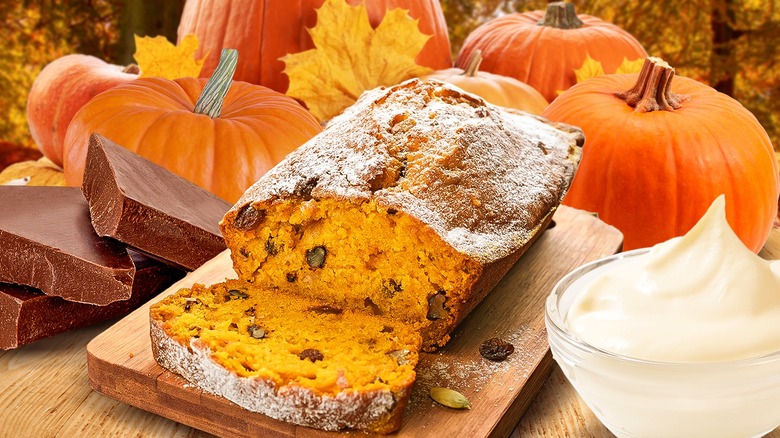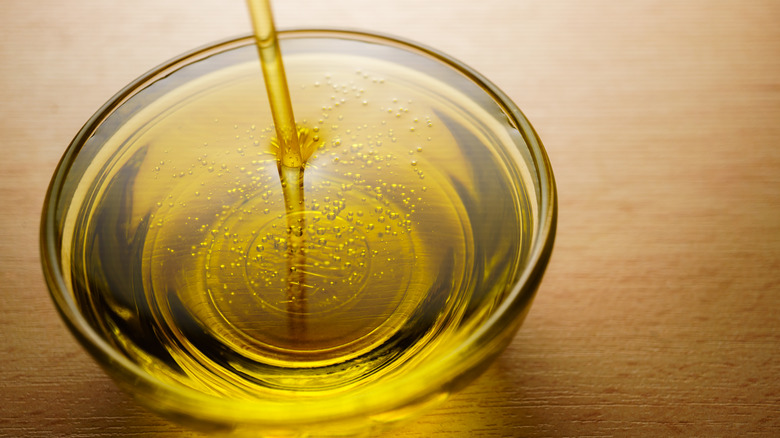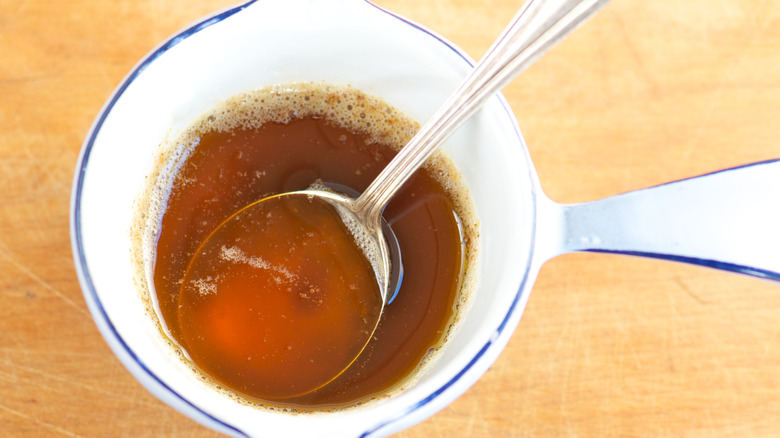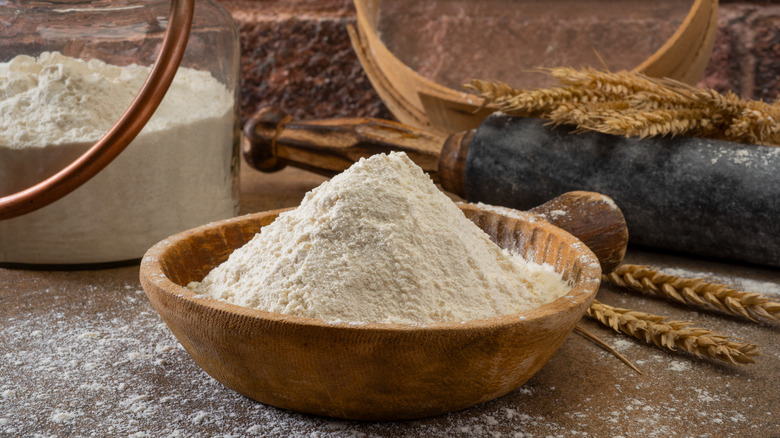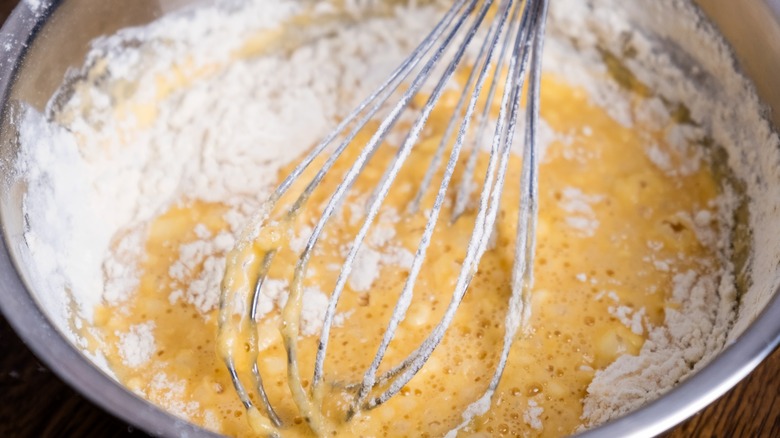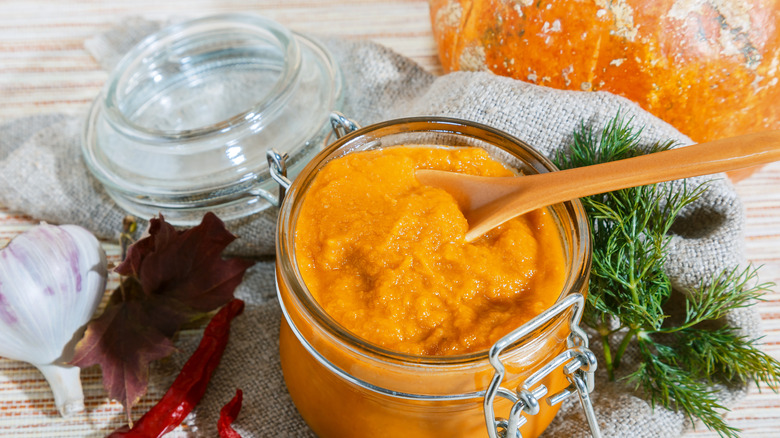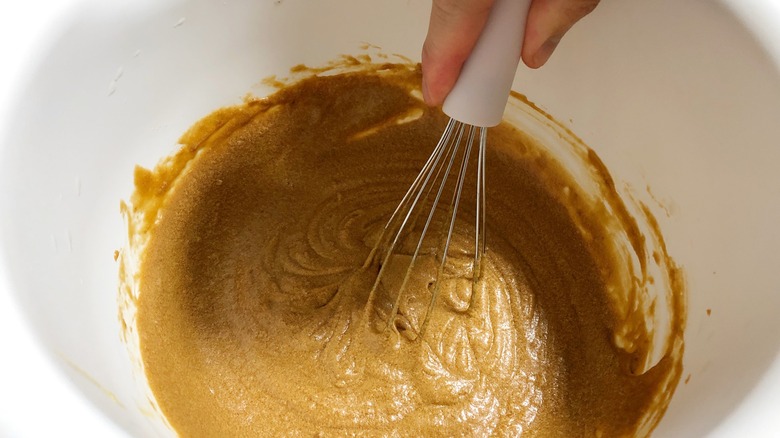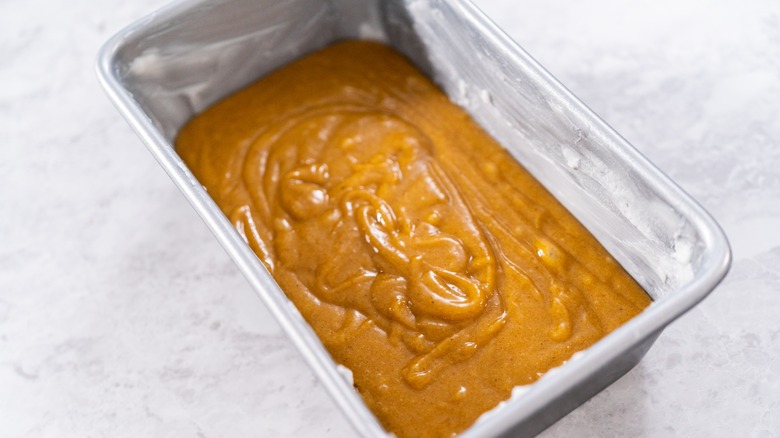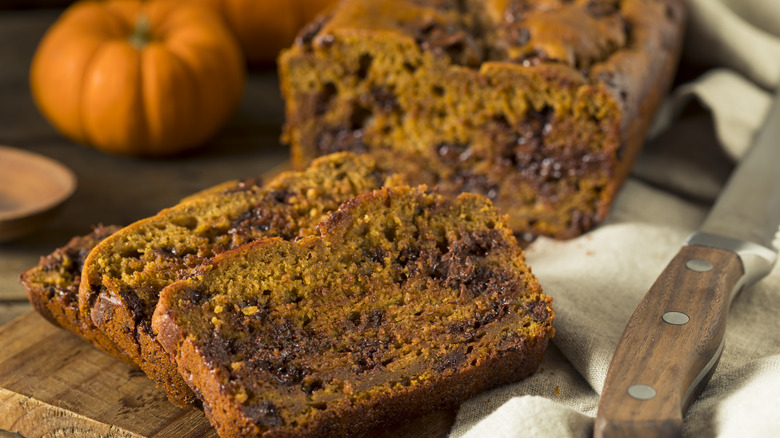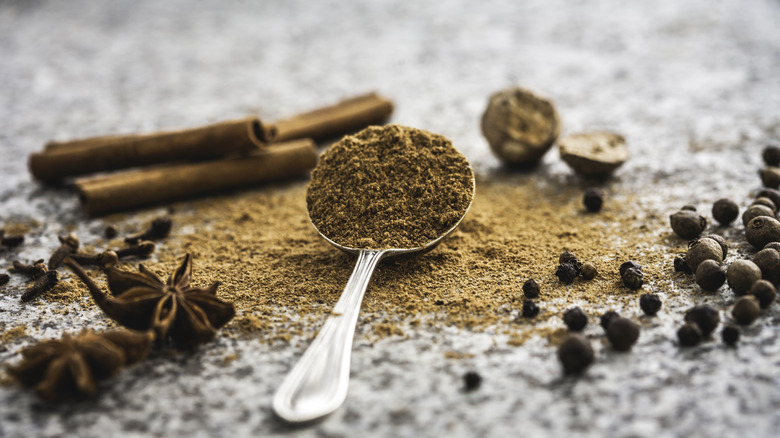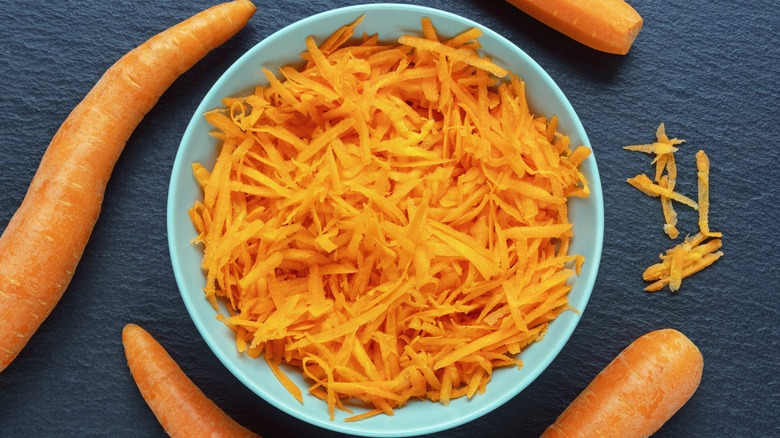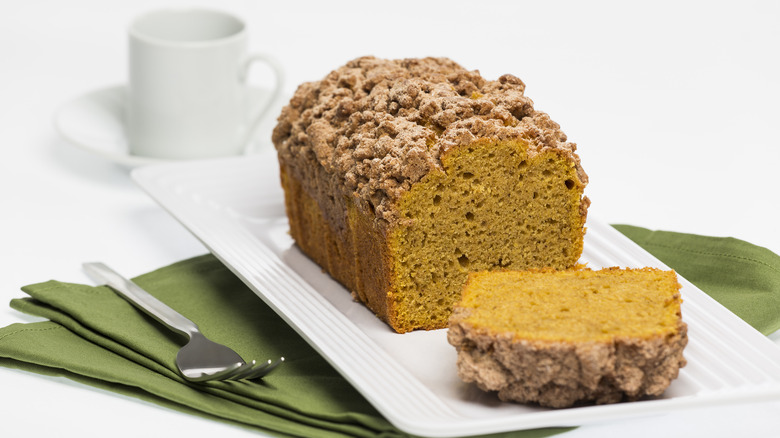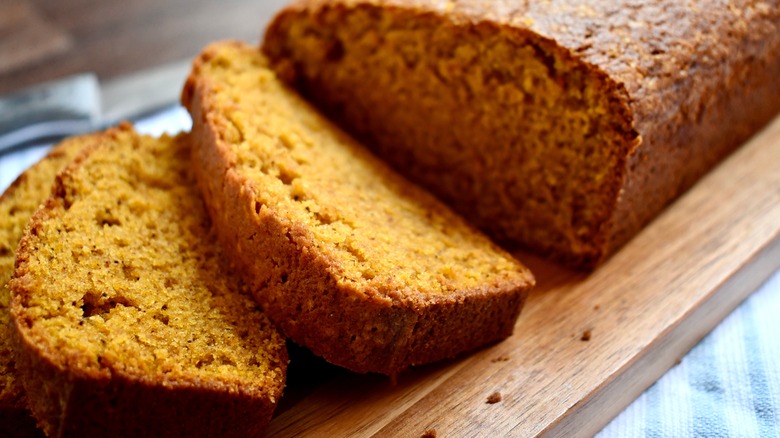13 Expert Tips To Bake The Absolute Best Pumpkin Bread
The leaves are falling, the mercury is dropping, and everyone is seemingly preparing to hibernate for the colder months ahead. The only item that could make this experience even better, of course, is pumpkin bread. This moist quick bread is brimming with autumnal spices, including cinnamon, cloves, ginger, and nutmeg, which makes it the perfect complement to cozy blankets and a warm cup of coffee in your hand.
As a home baker, pumpkin bread is one of my favorite treats to make during the fall months. And it's not because it's relatively simple; it's also something that I seemingly can't put down once I start eating it. Each slice is perfectly moist and supple and has a beautiful flavor balance of all things sweet and warming. I've perfected my pumpkin bread recipe over the years with tons of practice, precision, and, of course, trial and error. Here are some of my best tips for crafting delicious pumpkin bread.
1. Use oil for the moistest pumpkin bread possible
One of the critical components of any quick bread, whether you're making a decadent pumpkin loaf or zucchini bread, is the fat. Fat not only brings flavor, but it also helps ensure that your bread stays moist and pliable. This is because the fat will coat the gluten, which in turn prevents it from getting overworked as easily.
There are two primary fats that you'll need to decide between when you go to whip up your pumpkin bread: oil and butter. Oil has a higher fat content than butter, which is typically around 80% butterfat and 20% water. This makes oil a superior addition to a pumpkin bread, which is a recipe where moisture is paramount. I will almost always select a pumpkin bread recipe based upon the presence of oil in it. I don't think that you can really taste the flavor of the butter in your recipe anyway, since the pumpkin is rather dominant. If you are really keen on that butter flavor, though, you may consider adding butter extract to the mix — but I don't think it's entirely necessary.
Moreover, you may see recipes that contain applesauce or mashed banana in lieu of the oil. Although I won't discount the caloric difference between the two, I will say that you'll never get an ethereally soft pumpkin bread with something that's low-fat.
2. Consider adding some browned butter to your recipe
Remember when I said that you should avoid pumpkin bread recipes with butter in them? Well ... I take that back — kind of. The one ingredient that I will add to my pumpkin bread to impart a toffee-like flavor to it is brown butter. Brown butter is made by cooking down butter in a pan so that the milk solids toast and some of the water evaporates. This gives you a concentrated, nutty fat that fundamentally changes the flavor of your pumpkin bread. It's an excellent complement to not only the squash flavor, but also the brown sugar, nuts, and extra add-ins in your recipe.
Making brown butter yourself requires some attention to detail — mainly, you can't walk away with your butter on the stove. Otherwise, it will burn and cause you to start the whole process over again. But once you have your brown butter in tow, you can add a little bit to your pumpkin bread and save the rest of the brown butter for some other use.
3. Play with different flours in your pumpkin bread recipe for a better flavor
The standard flour for a pumpkin bread recipe is undeniably white wheat flour. Did you hear me yawn right there? Exactly — there's nothing special about its flavor or its consistency. Granted, its gluten content will give you a reliable bake every time, but why wouldn't you broaden your horizons a bit and expand to different types of flour?
My go-to for pumpkin bread is a mixture of equal parts whole wheat flour and white flour. The gluten content of the whole wheat variety isn't too far off from the regular stuff, which means you won't have to change your baking routine too much to accommodate for it (like you would for bread flour or pastry flour). Whole wheat flour will also impart a subtle nuttiness that is absolutely delectable when paired with other tasty additions, like a streusel topping.
But you can also venture into other flours for your pumpkin bread, too. Buckwheat would be a solid option; it's excellent at maintaining moisture and will impart a more organic flavor to your bake, but it will also make your bread inherently more dense. I would recommend cutting it with white flour to lighten things up a bit and make for a bite that's familiar but new at the same time.
4. Expedite the process with boxed cake mix
Nobody likes to take shortcuts when it comes to baking. Although they might make your job easier, it can make you feel like less of a home baker. But why would there be a perfectly good array of boxed cake mixes out there if you can't use them?
It's easy to make a pumpkin bread with boxed cake mix. The best part is that you'll only need to add the cake mix, a little liquid, spices, and the pumpkin puree into the mixture in order to make it work. The cake mix has all of the leavener, sugar, and flour you need, perfectly measured out for you. And the best part is? Nobody who eats it will even know the difference. A standard vanilla cake mix will give you an average loaf, but I would recommend grabbing a box of spice cake mix instead. Of course, you can be heavy-handed with your own spices, but this particular mix has a good balance of cinnamon, cloves, and nutmeg already in it to get you started.
5. Add extra moisture to your pumpkin bread with sour cream or Greek yogurt
Moisture is the key to a delicious pumpkin bread. You have your common ingredients — like the oil, the brown sugar (depending on the recipe), and the eggs — and then you have your ingredients that are kind-of-but-not-really out of left field. One of my favorites to use for quick breads in general is Greek yogurt. This dairy product is super fatty and creamy, and the moisture doesn't easily evaporate when your loaf hits the oven. The other option would be to use a scoop of sour cream; the lactic acid will help keep the gluten strands short, which means that your cake will have a softer and more decadent bite. The slight tang will also offset the overwhelming sweetness of the bread and result in a more balanced bite.
If you're looking to add an extra dose of fat and an improved mouthfeel to your loaf, you may also want to try swirling in full-fat cream cheese. I recommend whipping your brick in the stand mixer before trying to marble it into the loaf pan; it will make it easier to spread.
6. Don't try to make your own pumpkin puree
Okay, I totally understand why someone would want to make their own pumpkin puree. It's all about being DIY and homestead-y and cutesy, but let me tell you something: It's a laborious task that no one, and I mean no one, should ever have to be subjected to. Plus, there's already a perfectly good, canned option at your local grocery store.
Pumpkin puree is just one of those ingredients that you should buy at the store instead of making it yourself. When you make your own pumpkin puree, you not only have to remove the seeds and roast the squash, but you also have to remove the skin, cook it down, and strain it to remove the extra water. This is a task that could take several hours, at least, for barely enough pumpkin puree to make a loaf of bread with. Plus, canned pumpkin puree is consistently textured (meaning that there are no unsightly hunks of pumpkin pieces), which makes it easier to work with. Pumpkin bread recipes are designed with this precision in mind, so adding a chunky or poorly made homemade puree may mess up the loaf entirely.
7. Avoid overmixing your pumpkin bread batter at all costs
One of the biggest mistakes that you can make with pumpkin bread, and the reason why it's likely turning out too dense and stodgy, is because you overmixed it. Pumpkin bread, and quick breads in general, tend to lean very dense and doughy — but they're not as elasticky as a loaf of normal bread. That's not only because quick breads are made with leavening agents like baking soda and baking powder (rather than yeast), but also because the flour is not worked so much so that it starts to form strong gluten strands — which is what you would need with something like a ciabatta or a sourdough boule.
When you mix your pumpkin bread batter, after you add your liquid, you're kickstarting the reaction of the water mixing with gluten and strengthening. The more you stir your batter, the more you activate the gluten, and the stodgier and more elastic your batter will get. This will yield a loaf that's hard to bite into, slice, and enjoy.
A couple of lumps in your dough is fine; just be sure to check for pockets of flour. Oh, and leave that stand mixer alone; you'll want to stir in the flour with a spatula so that you can minimize how much movement it receives. I find it's easier to tell when your mixture is over-beaten when you're mixing it by hand, because you can feel when it starts to fight back.
8. Mix and bake in a timely manner
You have to be very conscientious of how long your loaf pan is sitting around on the counter in between the stages of preparing the batter and getting it into the oven. The primary reason for this is because your quick bread is leavened with baking soda, baking powder, or a mix of the two. While these leavening agents are overall quite strong, they don't last forever. So while you're tinkering around in your kitchen, cleaning the counters, and the like, your pumpkin bread is drasticially losing bubbles, leavening power, and lift.
When I bake quick breads, I preheat the oven before I do anything else, as this is typically the rate-limiting step when it comes to baking. Or, if I know that I'm working with a particularly slow oven, I'll wait to add any of those wet ingredients into the dry ones. This will, in turn, prevent the leavening agents from starting their reaction too prematurely.
9. Add a bit of chocolate to the pumpkin bread mix
The only thing better than a decadent loaf of pumpkin bread is one that's studded with chocolate chips or chunks. Not only do I love the sweetness that chocolate can add to pumpkin bread, but I can also appreciate how the molten bits add to a unique mouthfeel and texture in the finished product. I would recommend that everyone add a couple handfuls of their chocolate of choice to the batter after the wet and dry ingredients have been mixed; just give it a couple stirs so the chocolate is well-distributed.
You could also add a chocolatey flavor to your pumpkin bread by adding a little bit of cocoa powder to the batter. This ingredient will impart a well-distributed cocoa flavor to your loaf, but you will have to sacrifice its beautiful orange hue. I recommend adding Dutch-processed cocoa powder instead of the natural stuff; it lacks the same acidity, so it won't interact with your leavening agents as much and alter the fundamental texture of your bread.
10. Don't skimp on the spices
Pumpkin bread recipes, I've found, tend to be quite conservative when it comes to the spices. While some might have you add a touch of nutmeg, allspice, and cloves, with a bit more cinnamon, I would argue that your pumpkin bread deserves big flavors and a heavy hand when it comes to spices. Cinnamon, of course, is the spice that you're going to want to add a lot of to your recipe. It can add a hefty dose of warmth and back-of-mouth heat, while the other spices are what transforms this recipe into a true pumpkin bread.
Besides these basic spices, you can also up the ante a little bit by adding in some extras. Although most pumpkin spice mixes already contain ginger, I like to add a little bit extra to the mix so that my pumpkin bread has a subtle (yet tasty) burn to it. And if you want to think a little more outside the pumpkin-bread box? A hint of Chinese five spice powder will do your recipe some good, too.
11. Use extra veggies and fruits in your pumpkin bread for texture and moisture
Don't get me wrong, I'm not denying that this recipe is indeed still a pumpkin bread. But you don't have to just stick to pumpkin to add extra flavor and texture to your loaf. Grated carrots and zucchini are two veggies that can give your quick bread a unique consistency and help pack on the moisture. Not to mention, it makes you feel a little bit better about eating your vegetables. You don't need to add as much of these veggies to the batter as you would if you were making a carrot cake or zucchini bread; just a handful or two will boost up the moisture and keep your bread light and supple.
You can also add some extra fruits to your bread, too. Use up your leftover bananas and try a pumpkin banana bread, or add a bit of applesauce to elevate your pumpkin bread experience. Just remember to account for the added moisture by scaling back on some of your other wet ingredients.
12. Add a topping to your loaf for a unique texture
Pumpkin bread, alone, is delicious. But when you add an extra topping for some textural diversity? Well, this simple addition can take your recipe from good to great. One of my favorite toppings for a pumpkin bread is a cinnamon-spiced streusel. Mix up flour, sugar, and spices with softened butter and gently sprinkle it on top of your bread before you bake it. You'll not only get the sweet flavor from this addition, but also a delightful crunchiness when you bite into it. And if you want a little more crunch, consider stirring some oats into your streusel topping. It's a win-win all the way.
If you want something a little less saccharine, you may also want to consider some pepitas (pumpkin seeds) instead. They're perfectly nutty and flavorful, but they still have that grassy flavor that will tie back well into the bread's pumpkin base.
13. Serve your pumpkin bread with a schmear on top
There is no denying that there is beauty in the simplicity of a slice of pumpkin bread, still warm from the oven, with nothing on it. But equally as delicious is a slice that's been toasted in the air fryer or the oven until it's slightly warm and crisp on the outside, but still soft on the inside. And the only thing that makes this slice experience better is a slab of butter, cream cheese, or an otherwise unique topping.
Butter will give you a sublime flavor and a little bit of saltiness. But my go-to for serving pumpkin bread is actually a schmear of maple butter. The spread has about the same viscosity as butter but with the sweetness of maple syrup. While it is sweet, it will tie in well to the pumpkin flavor in your loaf and make for the perfect autumnal bite.
Static Media owns and operates Tasting Table and Mashed.
